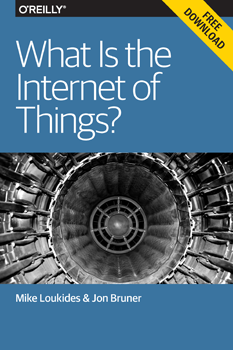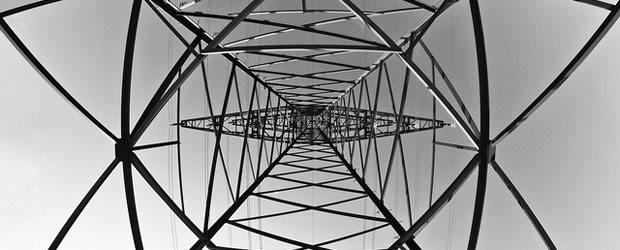Jon Bruner
Rebooting a 1970s satellite with modern software and hardware
The O'Reilly Solid Podcast: Dennis Wingo on reestablishing contact with a satellite that had been silent for 17 years.
Subscribe to the O’Reilly Solid podcast to stay on top of topics related to the Internet of Things, hardware, software, manufacturing, and the blurring of the physical and virtual worlds.
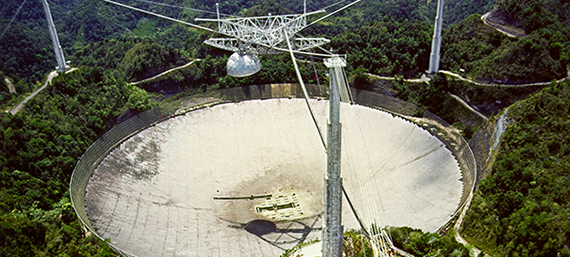
The Arecibo Observatory in Puerto Rico, where Dennis Wingo and his team established contact with the ISEE-3 satellite. Public domain image: Wikipedia.
In the first episode of the Solid Podcast, we talked with Dennis Wingo, founder of Skycorp, in the former NASA McDonald’s where he’s been restoring the first images of the moon taken from space.
After an hour of recounting his techno-archaeology exploits — reverse-engineering the arcane analog image-transmission systems that NASA’s engineers developed in the 1960s — Dennis paused and said, “and that’s just one of our history projects.”
That teaser is where we begin today’s episode. Ready to apply modern computing to another analog challenge, Dennis turned his attention to the reboot of the International Sun/Earth Explorer-3, a research satellite launched in 1978 and commended to the heavens in 1997.
NASA decommissioned the equipment for communicating with the satellite in 1999, so Dennis set about reverse-engineering the ISEE-3’s control system and devising a way to communicate with it. In the 1970s, he would have needed custom analog hardware, but now, general-purpose hardware is powerful enough that he could do it all with software. Read more…
Solid Podcast: Trip to McMoon’s
Dennis Wingo on the Lunar Orbiter Image Recovery Project, the project's Indiegogo campaign, and Skycorp.
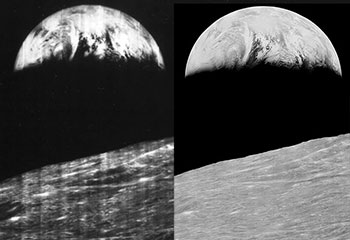
Before and after: The first “Earthrise” image, taken by the Lunar Orbiter 1 satellite and recovered by Dennis Wingo’s Lunar Orbiter Image Recovery Project. Credit: NASA/Skycorp Incorporated.
We’re kicking off our newest series, the O’Reilly Solid Podcast, with an episode recorded in the manager’s office of a McDonald’s at NASA’s Ames Research Center. David Cranor and I visited McMoon’s, as it’s known, to talk with Dennis Wingo, founder of two audacious “techno archaeology” efforts.
In the first episode, we discuss the Lunar Orbiter Image Recovery Project, which has rescued NASA’s first high-resolution images from satellites orbiting the moon. Dennis’ team reverse-engineered the extraordinary analog image transmission system that the satellites used in 1966 and 1967, digitized 14 tons of magnetic tape, and interpreted them to compose imagery at vastly higher resolution than NASA was originally able to recover from the satellites. Read more…
The Internet of Things is really about software
Our new report, "What is the Internet of Things," traces the IoT's transformations and impact.
One of the reasons that it’s ubiquitous is that it bears on practically everything. A few years ago, many companies might plausibly have argued that they weren’t affected by developments in software. If you dealt in physical goods, it was hard to see how software that existed strictly in the virtual realm might touch your business.
The Internet of Things changes that; the kinds of software intelligence that have already revolutionized industries like finance and advertising are about to revolutionize all the other industries.
Mike Loukides and I have traced out our idea of the Internet of Things and its impacts in a report, “What is the Internet of Things,” that’s available for free here.
As much as we all love the romance and gratification of hardware, the Internet of Things is really about software; the hardware just links the Internet to the rest of the world. If you think of the IoT as a newly developing area in software, it’s easy to draw out some characteristics of it that are analogous to things we’ve seen in web software over the last decade or so. Read more…
Biology as the next hardware
Why DNA is on the horizon of the design world.
I’ve spent the last couple of years arguing that the barriers between software and the physical world are falling. The barriers between software and the living world are next.
At our Solid Conference last May, Carl Bass, Autodesk’s CEO, described the coming of generative design. Massive computing power, along with frictionless translation between digital and physical through devices like 3D scanners and CNC machines, will radically change the way we design the world around us. Instead of prototyping five versions of a chair through trial and error, you can use a computer to prototype and test a billion versions in a few hours, then fabricate it immediately. That scenario isn’t far off, Bass suggested, and it arises from a fluid relationship between real and virtual.
Biology is headed down the same path: with tools on both the input and output sides getting easier to use, materials getting easier to make, and plenty of computation in the middle, it’ll become the next way to translate between physical and digital. (Excitement has built to the degree that Solid co-chair Joi Ito suggested we change the name of our conference to “Solid and Squishy.”)
I spoke with Andrew Hessel, a distinguished research scientist in Autodesk’s Bio/Nano/Programmable Matter Group, about the promise of synthetic biology (and why Autodesk is interested in it). Hessel says the next generation of synthetic biology will be brought about by a blend of physical and virtual systems that make experimental iteration faster and processes more reliable. Read more…
What you need to know for the hardware-software convergence
Core competencies and essential reading from hardware, software, manufacturing, and the IoT.
As I noted in “Physical and virtual are blurring together,” we now have hardware that acts like software, and software that’s capable of dealing with the complex subtleties of the physical world. So, what must the innovator, the creator, the executive, the researcher, and the artist do to embrace this convergence of hardware and software?
At its core, this is about a shift from discipline toward intent. Individuals and institutions — whether they’re huge enterprises, small start-ups, or nonprofits — must be competent in several disciplines that increasingly overlap, and should be prepared to solve problems by working fluidly across disciplines.
To use Joi Ito’s example, someone who wants to develop a synthetic eye might begin to approach the problem with biology, or electronics, or software, or (most likely) all three together. Many problems can be solved somewhere in a large multidimensional envelope that trades off design, mechanics, electronics, software, biology, and business models. Experts might still do the best work in each discipline, but everyone needs to know enough about all of them to know where to position a project between them.
Below you’ll find the core competencies in the intersection between software and the physical world, and our favorite books and resources for each one.
Electronics for physical-digital applications
- Practical Electronics, by John M. Hughes: To know what’s possible and where to start, it’s essential to understand both the analog and digital sides of electronics. This is O’Reilly’s authoritative introduction to both analog and digital electronics, with information on circuit design, common parts and techniques, and microcontrollers.
- Raspberry Pi Cookbook, by Simon Monk: The Raspberry Pi is rapidly becoming the standard embedded computing platform for prototyping and experimentation, with enough computing power to run familiar interpreted programming languages and widely supported operating systems.
- Arduino Cookbook, by Michael Margolis: The Arduino microcontroller offers a fluid interface between digital and physical; it’s highly extensible and accessible to people with no prior experience in either electronics or code.
Physical and virtual are blurring together
Key signals from hardware, software, manufacturing, and the Internet of Things.
![]()
This essay updates a November 2013 article. We’ve expanded it in light of the success of our first Solid conference in May 2014, where we tested many of these ideas, and the announcement of our next Solid conference in June 2015. In addition to this update, you can stay in the loop on the latest developments in the space through our weekly newsletter.
Real and virtual are crashing together. On one side is hardware that acts like software: IP-addressable, programmable with high-level procedural languages and APIs, able to be stitched into loosely coupled systems — the mashups of a new era. On the other is software that’s newly capable of dealing with the complex subtleties of the physical world — ingesting huge amounts of data, learning from it, and making decisions in real time.
The result is an entirely new medium that’s just beginning to emerge. We can see it in Ars Electronica Futurelab’s Spaxels, which are LED-equipped quadcopters that make up a drone swarm to render a three-dimensional pixel field; in Baxter, which layers emotive software onto an industrial robot so that anyone can operate it safely and efficiently; in OpenXC, which gives even hobbyist-level programmers access to the software in their cars; and in SmartThings, which ties web services to light switches.
The new medium is something broader than terms like “Internet of Things,” “Industrial Internet,” or “connected devices” suggest. It’s an entirely new discipline that’s being built by software developers, roboticists, manufacturers, hardware engineers, artists, and designers. Read more…
Solid 2015: submit your proposal
O'Reilly's Solid Conference, on IoT and the intersection between real and virtual, will return to San Francisco on June 23-25, 2015.
Last May, we engaged in something of an experiment when Joi Ito and I presented Solid, our conference about the intersection between software and the physical world. We drew the program as widely as possible and invited demos from a broad group of large and small companies, academic researchers, and artists. The crowd that came — more than 1,400 people — was similarly broad: a new interdisciplinary community that’s equally comfortable in the real and virtual worlds started to, well, solidify.
I’m delighted to announce that Solid is returning. The next Solid will take place on June 23-25, 2015, at Fort Mason in San Francisco. It’ll be bigger, with more space and a program spread across three days instead of two, but we’re taking care to maintain and nourish the spirit of the original event. That begins with our call for proposals, which opens today. Some of our best presentations in May came from community members we hadn’t yet met who blew away our program committee with intriguing proposals. We’re committed to discovering new luminaries and giving them a chance to speak to the community. If you’re working on interesting things, I hope you’ll submit a proposal.
We’re expecting a full house at this year’s event, so we’ve opened up ticket reservations today as well — you can reserve your ticket here, and we’ll hold your spot for seven days once registration opens early next year. Read more…
Saul Griffith: build soft, not solid
Soft, or compliant, robots can be safer, lighter, more efficient, and easier to control.
As we get ready to launch the 2015 version of Solid, our conference about the intersection between software and the physical world, I’ve been revisiting some lessons from Solid 2014.
For instance, Saul Griffith, founder and principal scientist at Other Lab, advises that many machines would do well to skip solidity altogether. Soft, or compliant, robots can be safer, lighter, more efficient, and easier to control. In his work with compliant robots, Griffith has managed to substitute intelligent controls for mass—replacing atoms with bits.
Watch Griffith’s entire Solid 2014 talk below. If you’d like to be notified when the Solid 2015 call for proposals goes up and when tickets become available, be sure to sign up for the O’Reilly IoT+ newsletter.
For more videos from Solid 2014, visit our Solid YouTube playlist.
The next industrial revolution
It's all about software, but it's a little harder than that.
If you Google “next industrial revolution,” you’ll find plenty of candidates: 3D printers, nanomaterials, robots, and a handful of new economic frameworks of varying exoticism. (The more generalized ones tend to sound a little more plausible than the more specific ones.)
The phrase came up several times at a track I chaired during our Strata + Hadoop World conference on big data. The talks I assembled focused on the industrial Internet — the merging of big machines and big data — and generally concluded that in the next industrial revolution, software will take on the catalytic role previously played by the water wheel, steam engine, and assembly line.
The industrial Internet is part of the new hardware movement, and, like the new hardware movement, it’s more about software than it is about hardware. Hardware has gotten easier to design, manufacture, and distribute, and it’s gotten more powerful and better connected, backed up with a big-data infrastructure that’s been under construction for a decade or so. Read more…
Intoxicating machines
The revolutionary thing about desktop machines is that they'll make experimentation easier.
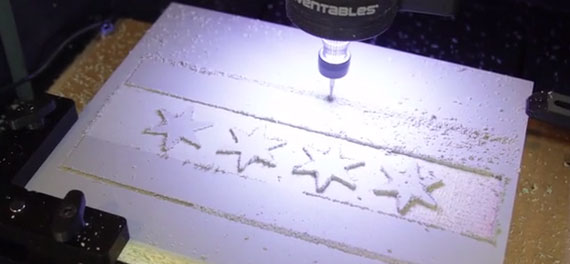
Cropped screenshot of Carvey. Source: the Carvey Kickstarter campaign.
“Mr. Frankel, who started this program, began to suffer from the computer disease that anybody who works with computers now knows about,” [Richard] Feynman later explained. “The trouble with computers is you play with them.”
— George Dyson, describing the beginning of the Manhattan Project’s computing effort in Turing’s Cathedral.
I’ve been reading George Dyson’s terrific history of the early development of the digital computer, and the quote above struck me. Even when they were little more than room-sized adding machines that had to be painstakingly programmed with punchcards, computers offered an intoxicating way to experiment. Most programmers can probably remember their first few scripts and the thrilling feeling of performing millions of operations in seconds. Computers let us take some abstracted human process and repeat it quickly, at almost no cost, with easy modification along the way. Read more…

